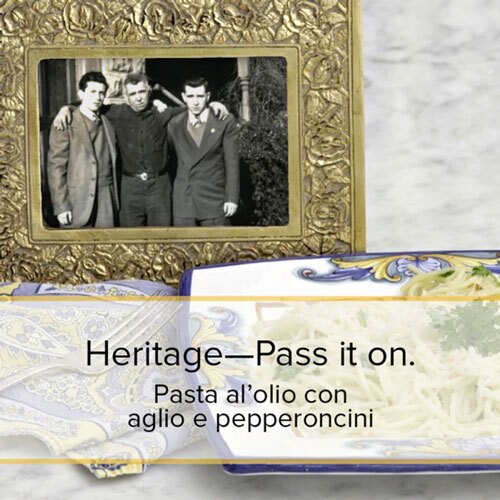FamilySearch press release manager Paul Nauta shares a story about how understanding his heritage inspired him to pass it on to his own family:

I’m second-generation Italian. My paternal grandfather was the only one in his family to immigrate to the United States. I was reunited with his family in Cagnano Varano, Italy, in my late twenties. It was fun to see how certain family traditions I had grown up with in the U.S. had their origins in my family roots in Italy.
Over the years, I’ve tried to reintroduce select family traditions from Italy into my family’s traditions in America. I was taught this pasta dish by my first cousins in Italy.
Pasta Aglio Olio e Peperoncino (Spaghetti with olive oil and sautéed garlic and hot peppers) is a lunch staple for my paternal family in Italy and has become a favorite for my family here. The recipe is easy and quick to make (few ingredients) and isn’t too heavy when you need to return to work after eating (if you only eat 4 ounces for a serving!).
I now grow my own pepperoncini peppers and use them in this dish. If you want to eat it for dinner or need to add protein, add grilled chicken, fish, or shrimp, seasoned in the same manner by sautéing with olive oil, garlic, and Italian seasonings.
Pasta Aglio Olio e Peperoncino
Makes 4 servings. Total prep/cook time: 20 minutes
Ingredients
- 16 oz spaghetti
- 4 large garlic cloves, peeled, finely chopped
- 2–3 pepperoncini (dried)
- ½ cup of olive oil
- 1 tsp of fresh parsley, finely chopped (optional)
- 1 tsp of salt (for pasta water and to add to the taste of the finished dish)
- Serve with grilled chicken, shrimp, or broiled fish with Italian seasoning for needed protein.
Directions
- Finely chop your garlic and two whole crushed pepperoncini (add a third one if you like more picante heat).
- Boil water for pasta. Add a teaspoon of salt when the water begins boiling.
- In a separate skillet or sauce pan, while the pasta is cooking, sauté the garlic and pepperoncini in the olive oil over low to medium heat until the garlic is lightly golden brown. I usually start this when the pasta al dente is about half done because the garlic browns quickly (takes no more than 5 minutes to sauté the garlic, so time it right). You don’t want to over sauté the garlic in the oil because it burns quickly and will change the taste of the dish. If your garlic browns before the pasta is cooked, turn off the heat and move it aside until the pasta is ready.
- Cook the pasta “al dente”—which literally translated means “at tooth”—in English, “not overcooked.” I was taught to test a strand of cooking spaghetti by biting it in half with my teeth. You want it to be cooked, but not more firm than limp or too soggy. If there’s a faint white center to the pasta when you bite it in half to test it, that’s usually about right.
- Take one or two cups of the pasta water and place it to the side before straining the pasta. When the pasta has been strained, add it to the skillet with the olive/garlic/pepperoncini oil and toss it. You want the pasta to be thoroughly coated by the oil. Add salt to taste.
- Add chopped parsley and grated parmesan lightly on top for slight taste and aesthetics. Make the rest of the parmesan cheese available on the table as a condiment your guests can add according to their individual tastes.
- Serve hot and fresh with garlic toast and a green salad or asparagus. Add grilled chicken, shrimp, or broiled fish for protein.
- If it dries out, add some of the pasta water that you held out to the side before straining. When storing leftovers in the fridge, I like to add the pasta water to keep it moist.
Paul was able to connect with his family by experiencing the culture through a variety of avenues, including food. How are you helping to pass on your family?
Check Out More of Our Favorite Family Recipes
Learn More about How Food Traditions Bring Families Together
At FamilySearch, we care about connecting you with your family, and we provide fun discovery experiences and family history services for free. Why? Because we cherish families and believe that connecting generations can improve our lives now and forever. We are a nonprofit organization sponsored by The Church of Jesus Christ of Latter-day Saints. To learn more about our beliefs, click here.






